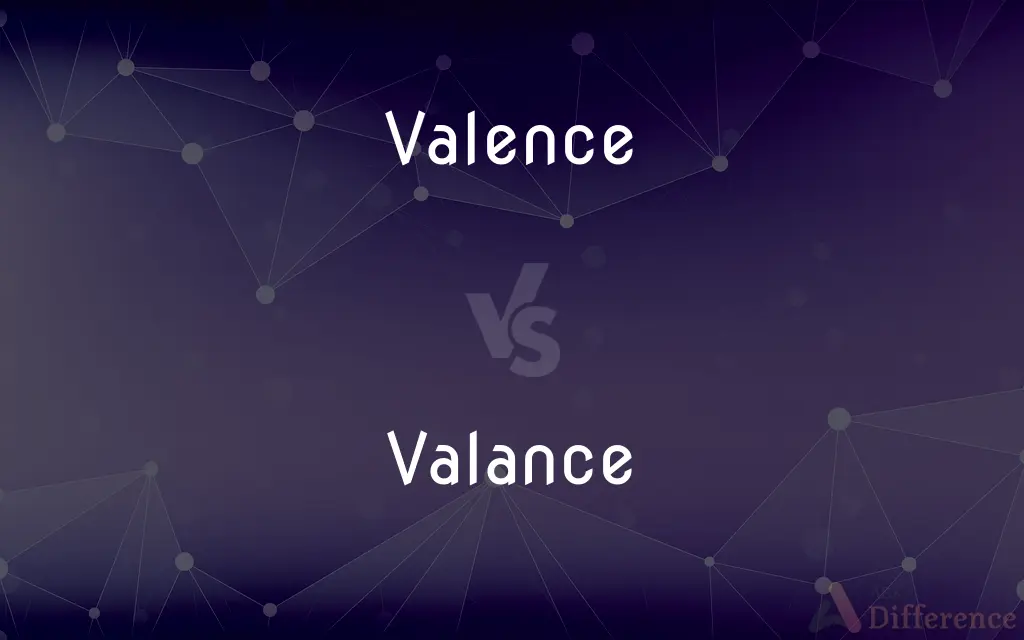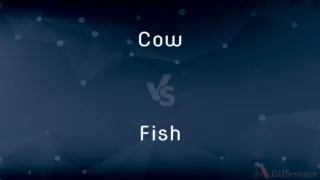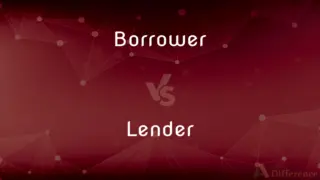Valence vs. Valance — What's the Difference?
Edited by Tayyaba Rehman — By Fiza Rafique — Updated on April 16, 2024
Valence refers to the combining capacity of an atom, essential in chemistry, whereas valance is a decorative drapery or framework hanging over a window.

Difference Between Valence and Valance
Table of Contents
ADVERTISEMENT
Key Differences
Valence is a concept in chemistry that describes how atoms combine based on the number of electrons in their outer shell, while valance, in interior design, refers to a piece of fabric designed to conceal curtain fixtures.
The term valence is critical for understanding molecular structures and reactions as it explains the bonding behavior of atoms; on the other hand, valance adds an aesthetic touch to a room, often enhancing the overall decor.
In educational settings, valence is taught as part of chemistry curricula to help students grasp the fundamentals of chemical bonding, whereas valance is discussed in courses on interior design and home decoration.
Valence can affect the physical and chemical properties of substances, influencing how elements react under different conditions, whereas the function of a valance is mainly decorative, having little to no functional role in a room’s environmental conditions.
The study of valence is essential for various scientific and industrial applications, including pharmaceuticals and materials science, while the choice of a valance can reflect personal taste and cultural aesthetics in home decor.
ADVERTISEMENT
Comparison Chart
Definition
Combining capacity of an atom in chemistry
Decorative drapery over a window
Primary Discipline
Chemistry
Interior Design
Role
Determines how atoms bond together
Adds aesthetic appeal to window treatments
Importance in Profession
Fundamental in scientific research and education
Essential in home decor and design
Related Terms
Electron, molecule, bond
Curtain, drapery, home aesthetics
Compare with Definitions
Valence
Occasionally used in discussions of emotional charge or resonance in various contexts.
The speech had a high emotional valence that resonated with many.
Valance
Part of a bed covering that hangs down over the sides of the bed, often matching the design of the bedspread.
The bedroom set came with a matching valance for the bed.
Valence
A concept in psychology referring to the intrinsic attractiveness or averseness of an event, object, or situation.
The positive valence of the reward motivated him to work harder.
Valance
In automotive design, a panel extending across the front or rear of a car, typically concealing structural equipment.
The car's front valance was damaged in the accident.
Valence
The capacity of an atom to combine with other atoms, measured by the number of electrons it can lose, gain, or share.
The valence of oxygen is typically two.
Valance
Used in theater settings to describe a short curtain or border hung along the top of the stage from the proscenium.
The valance hid the lighting equipment from the audience's view.
Valence
In mathematics, a term used in graph theory to describe the number of edges connected to a vertex.
In a simple triangle, each vertex has a valence of two.
Valance
Sometimes used metaphorically to suggest something that serves to cover or obscure.
The company's outreach efforts were just a valance to distract from its environmental record.
Valence
Used in linguistics to describe the number of arguments a verb requires to complete its meaning.
In the sentence She gave him a book, gave has a valence of three.
Valance
A short ornamental piece of drapery, cloth, or other material hung above a window to frame it.
She added a floral valance to brighten the kitchen.
Valence
Another term for valency
Valance
A length of decorative drapery attached to the canopy or frame of a bed in order to screen the structure or the space beneath it.
Valence
The combining capacity of an atom or group of atoms as determined by the number of electrons it can lose, add, or share when it reacts with other atoms or groups. Also called oxidation state.
Valance
An ornamental drapery hung across a top edge, as of a bed, table, or canopy.
Valence
An integer used to represent this capacity, which may be given as positive or negative depending on whether electrons are lost or gained, respectively
The valences of copper are +1 and +2.
Valance
A short drapery, decorative board, or metal strip mounted especially across the top of a window to conceal structural fixtures.
Valence
The number of binding sites of a molecule, such as an antibody or antigen.
Valance
To supply with valances or a valance.
Valence
The number of different antigens contained in a vaccine, corresponding to the number of pathogens that it is active against.
Valance
A short curtain that usually hangs along the top edge of a window.
Valence
(Psychology) The degree of attraction or aversion that an individual feels toward a specific object or event.
Valance
A decorative framework used to conceal the curtain mechanism and so on at the top of a window.
Valence
(Linguistics) The number and type of arguments that a lexical item, especially a verb, can combine with to make a syntactically well-formed sentence, often along with a description of the categories of those constituents. Intransitive verbs (appear, arrive) have a valence of one—the subject; some transitive verbs (paint, touch), two—the subject and direct object; other transitive verbs (ask, give), three—the subject, direct object, and indirect object.
Valance
(bedding) A short, decorative edging of cloth that hangs from beneath the mattress to the floor used to conceal the boxspring or space under the bed and prevent dust from accumulating there.
Valence
The capacity of something to unite, react, or interact with something else
"I do not claim to know much more about novels than the writing of them, but I cannot imagine one set in the breathing world which lacks any moral valence" (Robert Stone).
Valance
A short, decorative edging of cloth that conceals the legs of a couch, sofa, etc.
Valence
The combining capacity of an atom, functional group, or radical determined by the number of atoms of hydrogen with which it will unite, or the number of electrons that it will gain, lose, or share when it combines with other atoms, etc.
Valance
The drooping edging of the lid of a trunk, which covers the joint when the lid is closed.
Valence
The number of binding sites of a molecule, such as an antibody or antigen.
Valance
Hanging drapery for a bed, couch, window, or the like, especially that which hangs around a bedstead, from the bed to the floor.
Valance of Venice gold in needlework.
Valence
The number of arguments that a verb can have, including its subject, ranging from zero to three or, less commonly, four.
In this assignment you will analyze each of the following sentences and determine the valence of the highlighted verb.
Valance
The drooping edging of the lid of a trunk, which covers the joint when the lid is closed.
Valence
A one-dimensional value assigned by a person to an object, situation, or state, that can usually be positive (causing a feeling of attraction) or negative (repulsion).
Anger and fear have negative valence
Valance
To furnish with a valance; to decorate with hangings or drapery.
His old fringed chair valanced around with party-colored worsted bobs.
Valence
The value which a person places on something.
Valance
A decorative framework to conceal curtain fixtures at the top of a window casing
Valence
Alternative spelling of valance
Valence
The degree of combining power of an atom (or radical) as shown by the number of atoms of hydrogen (or of other monads, as chlorine, sodium, etc.) with which it will combine, or for which it can be substituted, or with which it can be compared; thus, an atom of hydrogen is a monad, and has a valence of one; the atoms of oxygen, nitrogen, and carbon are respectively dyads, triads, and tetrads, and have a valence respectively of two, three, and four.
Valence
(biology) a relative capacity to unite or react or interact as with antigens or a biological substrate
Valence
(chemistry) a property of atoms or radicals; their combining power given in terms of the number of hydrogen atoms (or the equivalent)
Common Curiosities
Can the concept of valence apply to compounds?
Yes, it describes how compounds form based on the valence of their constituent atoms.
How do different elements have different valences?
Elements have different valences based on the configuration of electrons in their outermost shells.
Is there a connection between valence in chemistry and psychology?
While both terms deal with connections (emotional in psychology, chemical in chemistry), they are used in very different contexts.
How does valence affect the stability of a molecule?
A higher valence can lead to more stable molecular structures, as atoms achieve full outer electron shells.
Are valances still popular in modern interior design?
Valances remain popular in various decor styles, particularly in traditional or classic settings.
What materials are commonly used to make valances?
Common materials include fabrics such as cotton, polyester, and silk, often decorated with patterns or embroidery.
What should one consider when choosing a valance for a room?
Factors to consider include the room’s color scheme, the style of other window treatments, and the desired aesthetic effect.
What is the purpose of valence in chemistry?
Valence helps predict how atoms will interact and bond with each other.
How does valance contribute to room decor?
A valance can enhance the visual appeal of a room by adding color, texture, and style to window treatments.
Can valances be used with all types of window treatments?
Yes, valances are versatile and can be used with blinds, shades, or curtains to add depth and interest.
Share Your Discovery

Previous Comparison
Cow vs. Fish
Next Comparison
Borrower vs. LenderAuthor Spotlight
Written by
Fiza RafiqueFiza Rafique is a skilled content writer at AskDifference.com, where she meticulously refines and enhances written pieces. Drawing from her vast editorial expertise, Fiza ensures clarity, accuracy, and precision in every article. Passionate about language, she continually seeks to elevate the quality of content for readers worldwide.
Edited by
Tayyaba RehmanTayyaba Rehman is a distinguished writer, currently serving as a primary contributor to askdifference.com. As a researcher in semantics and etymology, Tayyaba's passion for the complexity of languages and their distinctions has found a perfect home on the platform. Tayyaba delves into the intricacies of language, distinguishing between commonly confused words and phrases, thereby providing clarity for readers worldwide.















































